
|
It is visible at 12-13 mag in the SWAN images (May 2, Vladimir Bezugly). Fading gradually. In the Northern Hemisphere, it is not observable now, but it will appear in July. It stays extremely low in the Southern Hemisphere. But it will become high in autumn.
Date(TT) R.A. (2000) Decl. Delta r Elong. m1 Best Time(A, h)
June 7 3 10.33 9 44.8 2.020 1.238 29 13.2 3:00 (252, -8)
June 14 3 35.72 11 13.1 2.033 1.253 29 13.2 2:58 (251, -7)
|

|
It brightened up to -3 mag due to the forward scattering in the SOHO coronagraph images (Oct. 9, 2024, Q.-c. Zhang, Charles S. Morris). It became a great comet of 0 mag on the ground. Now it is 13.3 mag (May 31, Thomas Lehmann). Fading slowly. In the Northern Hemisphere, it stays observable in good condition. It locates somewhat low in the Southern Hemisphere. But it will become high in spring.
Date(TT) R.A. (2000) Decl. Delta r Elong. m1 Best Time(A, h)
June 7 19 34.06 28 34.4 3.479 4.038 116 13.3 2:33 ( 0, 84)
June 14 19 23.89 28 55.3 3.503 4.118 120 13.4 1:56 ( 0, 84)
|

|
It brightened up to 11 mag in the SWAN images (Jan. 27, Vladimir Bezugly). It will fade out rapidly after this. Now it is not observable. It will appear in July in the Southern Hemisphere, or in September in the Northern Hemisphere.
Date(TT) R.A. (2000) Decl. Delta r Elong. m1 Best Time(A, h)
June 7 5 9.50 5 53.2 2.367 1.428 16 13.7 20:57 (122,-29)
June 14 5 31.26 5 23.1 2.424 1.491 17 14.0 21:01 (124,-32)
|

|
It approached to Sun down to 0.09 a.u. on Jan. 13. It brightened up to -2 or -3 mag and it was detected even in the daylight. The nucleus was disintegrated on Jan. 19. However, its remnant is still visible. Fading gradually. In the Northern Hemisphere, it will never be observable after this. In the Southern Hemisphere, it stays observable in good condition.
Date(TT) R.A. (2000) Decl. Delta r Elong. m1 Best Time(A, h)
June 7 2 49.66 -55 47.0 2.881 2.940 83 14.0 3:00 (318,-35)
June 14 3 1.15 -57 43.1 2.922 3.037 86 14.2 2:58 (321,-33)
|
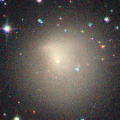
|
Now it is 13.0 mag (June 5, Osamu Miyazaki). It will be unobservable in July in the Northern Hemisphere, or in August in the Southern Hemisphere. But it will be observable again in October in the Northern Hemisphere.
Date(TT) R.A. (2000) Decl. Delta r Elong. m1 Best Time(A, h)
June 7 9 46.14 9 54.6 6.568 6.281 69 14.1 20:57 ( 83, 27)
June 14 9 49.20 9 37.9 6.670 6.282 63 14.1 21:01 ( 87, 21)
|

|
Now it is 13.8 mag (June 4, Toshihiko Ikemura, Hirohisa Sato). Fading slowly. It stays observable in good condition.
Date(TT) R.A. (2000) Decl. Delta r Elong. m1 Best Time(A, h)
June 7 15 9.60 -3 23.7 4.517 5.397 147 14.1 22:06 ( 0, 52)
June 14 15 7.67 -2 46.8 4.598 5.417 140 14.2 21:36 ( 0, 52)
|

|
Now it is 14.9 mag (Feb. 4, Alfons Diepvens). It stays 14 mag for a while. In the Northern Hemisphere, it will be getting higher gradually. It locates somewhat low in the Southern Hemisphere.
Date(TT) R.A. (2000) Decl. Delta r Elong. m1 Best Time(A, h)
June 7 2 4.58 17 7.9 4.557 3.856 41 14.2 3:00 (255, 9)
June 14 2 13.08 17 58.1 4.485 3.848 45 14.1 2:58 (257, 13)
|
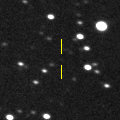
|
Now it is 15.2 mag (May 10, Taras Prystavski). Fading slowly. In the Northern Hemisphere, it will be getting higher gradually. In the Southern Hemisphere, it stays observable in good condition.
Date(TT) R.A. (2000) Decl. Delta r Elong. m1 Best Time(A, h)
June 7 1 51.52 1 16.2 2.641 2.144 50 14.6 3:00 (270, 3)
June 14 2 4.71 2 8.8 2.603 2.163 53 14.6 2:58 (271, 6)
|

|
It brightened rapidly up to 7.8 mag on Apr. 8 (Osamu Miyazaki). The nucleus was disintegrated, however, its remnant is still visible. Fading rapidly. It will be fainter than 18 mag in August. In the Northern Hemisphere, it will never be observable after this. In the Southern Hemisphere, it will be getting higher gradually.
Date(TT) R.A. (2000) Decl. Delta r Elong. m1 Best Time(A, h)
June 7 5 36.43 -19 31.5 1.447 0.991 43 14.7 20:57 ( 93,-40)
June 14 5 44.45 -23 58.3 1.533 1.128 47 15.2 21:01 ( 91,-47)
|
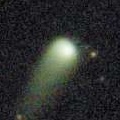
|
It was observed at 12-13 mag for a long time in 2024. Now it is 14.9 mag (June 1, Ken-ichi Kadota). It stays 15 mag for a while. In the Northern Hemisphere, it stays observable in good condition. In the Southern Hemisphere, it is not observable now, but it will appear in September.
Date(TT) R.A. (2000) Decl. Delta r Elong. m1 Best Time(A, h)
June 7 1 53.33 50 48.6 5.005 4.356 45 14.7 3:00 (225, 28)
June 14 1 53.19 51 26.6 4.975 4.388 49 14.8 2:58 (226, 32)
|

|
Now it is 14.6 mag (May 10, Alfons Diepvens). It stays 15 mag for a while. In the Northern Hemisphere, it is not observable now, but it will appear in August. In the Southern Hemisphere, it will be unobservable soon. But it will be observable again in August.
Date(TT) R.A. (2000) Decl. Delta r Elong. m1 Best Time(A, h)
June 7 7 9.25 17 21.5 6.369 5.522 30 14.9 20:57 (111, 0)
June 14 7 15.53 17 35.9 6.414 5.516 25 15.0 21:01 (115, -5)
|

|
It is expected to brighten up to 5 mag in 2026 January. Now it is 15.7 mag (June 1, Ken-ichi Kadota). Brightening gradually. In the Northern Hemisphere, it stays observable in good condition. In the Southern Hemisphere, it is not observable now, but it will appear in July.
Date(TT) R.A. (2000) Decl. Delta r Elong. m1 Best Time(A, h)
June 7 17 34.76 58 13.3 3.327 3.623 98 15.2 0:34 (180, 67)
June 14 17 21.48 58 14.1 3.244 3.540 98 15.0 23:48 (180, 67)
|
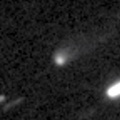
|
Now it is 15.2 mag (June 3, Thomas Lehmann). It stays 16 mag for a while. It locates somewhat low in the Northern Hemisphere. In the Southern Hemisphere, it stays observable in good condition.
Date(TT) R.A. (2000) Decl. Delta r Elong. m1 Best Time(A, h)
June 7 18 54.87 -29 57.2 1.983 2.926 153 15.1 1:55 ( 0, 25)
June 14 18 50.74 -30 28.6 1.949 2.926 160 15.1 1:23 ( 0, 25)
|

|
Now it is 14.5 mag (May 23, Thomas Lehmann). Fading gradually. It will be fainter than 18 mag in September. It will be unobservable in July.
Date(TT) R.A. (2000) Decl. Delta r Elong. m1 Best Time(A, h)
June 7 7 25.87 24 40.9 2.308 1.564 33 15.1 20:57 (115, 8)
June 14 7 49.09 24 42.1 2.364 1.595 31 15.4 21:01 (116, 6)
|
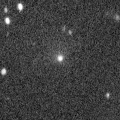
|
Very large comet. It is expected to brighten up to 13 mag in 2031. Now it is 14.7 mag (May 24, Thomas Lehmann). It stays 15 mag for a while. In the Northern Hemisphere, it is not observable now. In the Southern Hemisphere, it stays observable in good condition. In the Northern Hemisphere, it is not observable until 2030.
Date(TT) R.A. (2000) Decl. Delta r Elong. m1 Best Time(A, h)
June 7 4 35.81 -65 30.2 15.062 15.067 88 15.2 3:00 (331,-47)
June 14 4 41.30 -65 37.7 15.021 15.044 89 15.2 2:58 (331,-45)
|

|
It is expected to brighten up to 13 mag in early summer in 2026. Now it is 15.9 mag (May 14, Ken-ichi Kadota). It stays 15 mag for a while. In the Northern Hemisphere, it stays observable in good condition. It locates somewhat low in the Southern Hemisphere. But it will become high in autumn.
Date(TT) R.A. (2000) Decl. Delta r Elong. m1 Best Time(A, h)
June 7 22 24.21 23 59.3 4.428 4.517 88 15.3 3:00 (280, 57)
June 14 22 19.07 24 29.4 4.276 4.480 95 15.2 2:58 (286, 64)
|

|
Now it is 16.5 mag (Apr. 7, Alfons Diepvens). It stays 15 mag for a while. Now it is not observable. It will appear in August.
Date(TT) R.A. (2000) Decl. Delta r Elong. m1 Best Time(A, h)
June 7 5 41.41 20 28.7 3.474 2.480 9 15.3 20:57 (127,-14)
June 14 5 55.97 20 20.4 3.477 2.472 6 15.3 21:01 (130,-16)
|

|
It will brighten up to 13 mag in 2026. Now it is 15.9 mag (June 2, Thomas Lehmann). It stays 15 mag for a while. It stays observable in good condition.
Date(TT) R.A. (2000) Decl. Delta r Elong. m1 Best Time(A, h)
June 7 19 34.54 -19 30.3 5.072 5.922 143 15.5 2:34 ( 0, 36)
June 14 19 30.19 -18 59.9 4.969 5.881 151 15.4 2:02 ( 0, 36)
|

|
It brightened up to 12.7 mag in 2024 summer (Aug. 7, 2024, Thomas Lehmann). Now it is 15.5 mag (June 4, Toshihiko Ikemura, Hirohisa Sato). It stays 16 mag for a while. In the Northern Hemisphere, it stays observable in good condition. In the Southern Hemisphere, it will be unobservable in August.
Date(TT) R.A. (2000) Decl. Delta r Elong. m1 Best Time(A, h)
June 7 23 31.47 38 13.1 3.425 3.226 70 15.5 3:00 (249, 48)
June 14 23 35.52 40 28.0 3.407 3.275 73 15.5 2:58 (247, 53)
|

|
Brightened rapidly. Now it is 14.6 mag (Jan. 31, Thomas Lehmann). Fading slowly. It locates somewhat low in the Northern Hemisphere. In the Southern Hemisphere, it will be getting higher gradually.
Date(TT) R.A. (2000) Decl. Delta r Elong. m1 Best Time(A, h)
June 7 1 58.41 8 27.7 2.642 2.066 45 15.5 3:00 (263, 6)
June 14 2 9.14 6 45.1 2.600 2.108 50 15.6 2:58 (267, 8)
|

|
Now it is 15.3 mag (May 13, Ken-ichi Kadota). Fading slowly. It will be unobservable in July in the Northern Hemisphere, or in August in the Southern Hemisphere.
Date(TT) R.A. (2000) Decl. Delta r Elong. m1 Best Time(A, h)
June 7 11 12.27 -6 54.0 3.288 3.533 95 15.8 20:57 ( 52, 32)
June 14 11 8.10 -5 42.1 3.445 3.549 87 16.0 21:01 ( 60, 27)
|

|
Now it is 15.3 mag (May 4, Toshiyuki Takahashi). Fading slowly. In the Northern Hemisphere, it will be unobservable in October. In the Southern Hemisphere, it stays observable in good condition.
Date(TT) R.A. (2000) Decl. Delta r Elong. m1 Best Time(A, h)
June 7 13 9.92 -25 27.7 3.037 3.747 127 15.8 20:57 ( 13, 28)
June 14 13 12.59 -24 34.1 3.130 3.767 121 15.9 21:01 ( 20, 27)
|

|
It brightened up to 14.4 mag in winter (Feb. 4, Ken-ichi Kadota). Now it is 16.1 mag (May 20, Thomas Lehmann). Fading slowly. It will be unobservable in July in the Northern Hemisphere, or in September in the Southern Hemisphere.
Date(TT) R.A. (2000) Decl. Delta r Elong. m1 Best Time(A, h)
June 7 9 39.24 9 56.2 2.907 2.691 67 15.9 20:57 ( 84, 26)
June 14 9 48.63 8 59.8 2.996 2.700 63 16.0 21:01 ( 86, 21)
|

|
Now it is 17.1 mag (May 7, ATLAS Chile). Brightening slowly. In the Northern Hemisphere, it will be getting higher gradually. In the Southern Hemisphere, it stays observable in good condition.
Date(TT) R.A. (2000) Decl. Delta r Elong. m1 Best Time(A, h)
June 7 23 8.36 -14 28.3 2.679 2.924 93 16.2 3:00 (310, 24)
June 14 23 13.57 -13 53.3 2.579 2.914 98 16.1 2:58 (313, 27)
|

|
Now it is 16.1 mag (May 14, Ken-ichi Kadota). It stays 16 mag for a while. In the Northern Hemisphere, it stays observable in good condition. In the Southern Hemisphere, it will never be observable after this.
Date(TT) R.A. (2000) Decl. Delta r Elong. m1 Best Time(A, h)
June 7 10 38.46 65 6.1 4.607 4.317 67 16.2 20:57 (151, 48)
June 14 10 41.93 64 51.1 4.660 4.315 64 16.3 21:01 (149, 45)
|

|
Now it is 16.2 mag (May 8, Ken-ichi Kadota). It stays 17 mag for a while. It will be unobservable soon in the Northern Hemisphere, or in September in the Southern Hemisphere. But it will be observable again in September in the Southern Hemisphere.
Date(TT) R.A. (2000) Decl. Delta r Elong. m1 Best Time(A, h)
June 7 10 38.05 -29 36.7 5.062 5.275 96 16.2 20:57 ( 43, 10)
June 14 10 36.49 -28 22.0 5.182 5.285 90 16.3 21:01 ( 49, 6)
|

|
Now it is 16.2 mag (May 13, ATLAS South Africa). It stays 16 mag for a while. In the Northern Hemisphere, it is not observable now, but it will appear in September. In the Southern Hemisphere, it will be unobservable in July. But it will be observable again in July.
Date(TT) R.A. (2000) Decl. Delta r Elong. m1 Best Time(A, h)
June 7 7 20.48 -12 8.6 7.209 6.588 48 16.5 20:57 ( 86,-15)
June 14 7 25.56 -11 41.1 7.261 6.584 45 16.5 21:01 ( 90,-20)
|

|
First return of a new periodic comet which brightened up to 15 mag in 2010. Now it is 16.0 mag (May 11, ATLAS-HKO, Haleakala). It will fade out rapidly after this. It will be fainter than 18 mag in July. It locates somewhat low in the Northern Hemisphere. It stays extremely low in the Southern Hemisphere.
Date(TT) R.A. (2000) Decl. Delta r Elong. m1 Best Time(A, h)
June 7 9 2.72 29 33.3 2.312 1.908 54 16.7 20:57 (107, 29)
June 14 9 21.85 27 59.3 2.398 1.949 52 16.9 21:01 (107, 25)
|

|
It will brighten up to 9 mag in 2026 spring. Now it is 17.7 mag (May 14, Ken-ichi Kadota). Brightening gradually. It will be getting lower gradually after this, and it will be unobservable in August in the Northern Hemisphere, or in September in the Southern Hemisphere.
Date(TT) R.A. (2000) Decl. Delta r Elong. m1 Best Time(A, h)
June 7 10 29.54 13 35.7 2.941 2.903 77 16.8 20:57 ( 79, 38)
June 14 10 34.64 12 55.3 2.996 2.862 72 16.7 21:01 ( 83, 32)
|

|
It is expected to brighten up to 7.5 mag in October. Now it is 16.8 mag (June 4, Toshihiko Ikemura, Hirohisa Sato). It will brighten rapidly after this. It will be getting lower gradually after this, and it will be unobservable in September in the Northern Hemisphere, or in October in the Southern Hemisphere. But it will be observable again in June in the Northern Hemisphere, or in August in the Southern Hemisphere. It is not observable for a month around the perihelion passage. But in the Northern Hemisphere, it stays observable in good condition until mid September and after late October. In the Southern Hemisphere, it is observable only before the perihelion passage.
Date(TT) R.A. (2000) Decl. Delta r Elong. m1 Best Time(A, h)
June 7 22 25.73 17 1.3 2.199 2.439 91 17.3 3:00 (290, 53)
June 14 22 23.56 18 5.5 1.983 2.336 97 16.9 2:58 (295, 59)
|
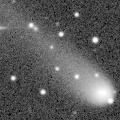
|
Now it is 16.4 mag (May 4, ATLAS South Africa). It stays 17 mag for a while. In the Northern Hemisphere, it is not observable now, but it will appear in September. In the Southern Hemisphere, it will be getting higher gradually.
Date(TT) R.A. (2000) Decl. Delta r Elong. m1 Best Time(A, h)
June 7 5 39.41 -36 18.4 7.991 7.531 59 16.9 20:57 ( 72,-46)
June 14 5 42.09 -36 13.0 8.040 7.576 59 16.9 21:01 ( 74,-52)
|
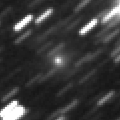
|
Very far object. Now it is 16.9 mag (Dec. 20, ATLAS Chile). It stays 17 mag for a while. In the Northern Hemisphere, it is not observable now. In the Southern Hemisphere, it stays observable in good condition.
Date(TT) R.A. (2000) Decl. Delta r Elong. m1 Best Time(A, h)
June 7 1 29.04 -53 27.4 10.726 10.751 88 17.0 3:00 (320,-23)
June 14 1 30.15 -53 39.0 10.670 10.761 92 17.0 2:58 (322,-20)
|
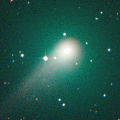
|
It was observed at 9-10 mag for a long time in 2023. Now it is 16.6 mag (May 15, ATLAS South Africa). It stays 18 mag for a while. In the Northern Hemisphere, it will never be observable after this. In the Southern Hemisphere, it stays observable in good condition.
Date(TT) R.A. (2000) Decl. Delta r Elong. m1 Best Time(A, h)
June 7 22 7.98 -69 35.5 7.068 7.565 115 17.0 3:00 (349,-17)
June 14 22 1.12 -70 33.7 7.071 7.617 119 17.1 2:58 (352,-17)
|

|
Now it is 18.0 mag (Feb. 2, ATLAS Chile). It stays 17 mag for a while. In the Northern Hemisphere, it is not observable now, but it will appear in July. In the Southern Hemisphere, it stays observable in good condition. It is expected to brighten up to 13 mag in winter between 2026 and 2027.
Date(TT) R.A. (2000) Decl. Delta r Elong. m1 Best Time(A, h)
June 7 2 39.71 -37 12.5 7.210 6.902 68 17.2 3:00 (298,-27)
June 14 2 45.09 -37 15.1 7.109 6.859 71 17.1 2:58 (300,-23)
|

|
Now it is 18.6 mag (June 4, Toshihiko Ikemura, Hirohisa Sato). It stays 17 mag for a while. It stays observable in good condition.
Date(TT) R.A. (2000) Decl. Delta r Elong. m1 Best Time(A, h)
June 7 21 53.07 3 22.5 2.908 3.303 104 17.2 3:00 (314, 49)
June 14 21 54.56 3 49.2 2.833 3.320 109 17.1 2:58 (322, 53)
|
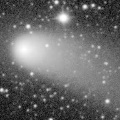
|
It brightened up to 9.6 mag from February to March in 2024 (Feb. 25, 2024, Thomas Lehmann). Now it is 17.6 mag (June 4, Toshihiko Ikemura, Hirohisa Sato). It stays 17 mag for a while. In the Northern Hemisphere, it stays observable in good condition. It stays extremely low in the Southern Hemisphere.
Date(TT) R.A. (2000) Decl. Delta r Elong. m1 Best Time(A, h)
June 7 23 40.76 40 57.2 6.004 5.700 67 17.2 3:00 (245, 47)
June 14 23 42.39 41 36.3 5.988 5.763 72 17.2 2:58 (245, 52)
|
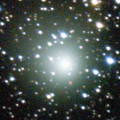
|
It brightened up to 8.3 mag in 2021-2022 winter (Jan. 6, 2022, Toshiyuki Takahashi). Now it is 17.7 mag (May 13, Jean-Claude Merlin). It stays 18 mag for a while. In the Northern Hemisphere, it will never be observable after this. In the Southern Hemisphere, it stays observable in good condition.
Date(TT) R.A. (2000) Decl. Delta r Elong. m1 Best Time(A, h)
June 7 11 50.65 -56 16.9 9.864 10.345 115 17.2 20:57 ( 17, -5)
June 14 11 51.23 -55 47.4 9.963 10.388 112 17.3 21:01 ( 21, -7)
|

|
Now it is 17.3 mag (Oct. 31, ATLAS Chile). It stays 17 mag for a while. In the Northern Hemisphere, it will be getting higher gradually. In the Southern Hemisphere, it stays observable in good condition.
Date(TT) R.A. (2000) Decl. Delta r Elong. m1 Best Time(A, h)
June 7 0 19.54 -2 19.0 3.472 3.314 72 17.3 3:00 (287, 19)
June 14 0 25.98 -1 50.5 3.383 3.318 77 17.3 2:58 (290, 23)
|

|
Now it is 17.3 mag (May 6, ATLAS Chile). It stays 18 mag for a while. It will be unobservable in July in the Northern Hemisphere, or in September in the Southern Hemisphere.
Date(TT) R.A. (2000) Decl. Delta r Elong. m1 Best Time(A, h)
June 7 11 3.99 -24 51.6 5.075 5.348 100 17.3 20:57 ( 41, 17)
June 14 11 4.10 -23 24.9 5.185 5.348 93 17.4 21:01 ( 48, 13)
|

|
It brightened up to 13.8 mag in winter (Dec. 30, Thomas Lehmann). Now it is 17.0 mag (May 14, Ken-ichi Kadota). Fading slowly. It will be fainter than 18 mag in July. It locates somewhat low in the Northern Hemisphere. It stays extremely low in the Southern Hemisphere.
Date(TT) R.A. (2000) Decl. Delta r Elong. m1 Best Time(A, h)
June 7 9 38.43 36 10.9 3.617 3.246 60 17.4 20:57 (111, 38)
June 14 9 47.45 34 24.1 3.734 3.289 56 17.6 21:01 (111, 33)
|
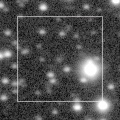
|
Now it is 16.5 mag (June 1, Toshihiko Ikemura, Hirohisa Sato). It stays 18 mag for a while. It stays observable in good condition.
Date(TT) R.A. (2000) Decl. Delta r Elong. m1 Best Time(A, h)
June 7 16 30.07 -19 57.1 5.657 6.664 172 17.5 23:26 ( 0, 35)
June 14 16 24.10 -19 9.8 5.668 6.652 164 17.5 22:52 ( 0, 36)
|

|
Now it is 17.3 mag (May 6, ATLAS Chile). It stays 18 mag for a while. In the Northern Hemisphere, it is not observable now, but it will appear in September. In the Southern Hemisphere, it will be getting lower gradually after this, and it will be unobservable in August. But it will be observable again in August.
Date(TT) R.A. (2000) Decl. Delta r Elong. m1 Best Time(A, h)
June 7 7 54.12 -21 10.7 4.068 3.686 61 17.5 20:57 ( 73,-13)
June 14 7 59.43 -19 29.8 4.147 3.682 56 17.5 21:01 ( 78,-18)
|

|
Now it is 17.9 mag (June 4, Toshihiko Ikemura, Hirohisa Sato). It stays 18 mag for a while. It stays observable in good condition.
Date(TT) R.A. (2000) Decl. Delta r Elong. m1 Best Time(A, h)
June 7 16 54.38 17 22.1 4.562 5.378 139 17.6 23:50 ( 0, 72)
June 14 16 51.80 17 16.7 4.553 5.356 138 17.6 23:20 ( 0, 72)
|

|
Now it is 17.5 mag (Apr. 28, Yasukazu Ikari). It stays 18 mag for a while. In the Northern Hemisphere, it stays observable in good condition. In the Southern Hemisphere, it is not observable now, but it will appear in August.
Date(TT) R.A. (2000) Decl. Delta r Elong. m1 Best Time(A, h)
June 7 17 33.66 63 42.3 4.940 5.100 93 17.6 0:33 (180, 61)
June 14 17 14.05 63 27.5 4.938 5.097 93 17.6 23:39 (180, 62)
|

|
It returns for the first time in 70 years. It brightened up to 3.7 mag in early April in 2024 (Apr. 6, 2024, Jose Guilherme Aguiar). Now it is 17.4 mag (May 24, Mike Olason). Fading slowly. It will be fainter than 18 mag soon. It stays extremely low in the Northern Hemisphere. In the Southern Hemisphere, it stays observable in good condition.
Date(TT) R.A. (2000) Decl. Delta r Elong. m1 Best Time(A, h)
June 7 15 55.37 -48 33.4 4.275 5.187 151 17.8 22:51 ( 0, 6)
June 14 15 48.17 -47 39.5 4.357 5.249 148 17.9 22:17 ( 0, 7)
|

|
It returned for the first time in 68 years. It brightened up to 6.2 mag in early last summer (July 1, Virgilio Gonano). Now it is 17.3 mag (May 24, Mike Olason). It will fade out rapidly after this. It locates somewhat low in the Northern Hemisphere. In the Southern Hemisphere, it stays observable in good condition.
Date(TT) R.A. (2000) Decl. Delta r Elong. m1 Best Time(A, h)
June 7 18 15.13 -27 52.1 3.321 4.299 162 17.8 1:15 ( 0, 27)
June 14 18 8.28 -28 25.2 3.360 4.363 169 18.0 0:41 ( 0, 27)
|
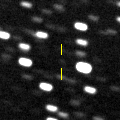
|
Now it is 17.3 mag (Mar. 6, ATLAS Chile). It stays 18 mag for a while. In the Northern Hemisphere, it will never be observable after this. In the Southern Hemisphere, it stays observable in good condition.
Date(TT) R.A. (2000) Decl. Delta r Elong. m1 Best Time(A, h)
June 7 3 19.90 -49 7.8 5.462 5.295 75 17.8 3:00 (309,-38)
June 14 3 22.11 -49 49.1 5.425 5.313 78 17.8 2:58 (311,-34)
|

|
Now it is 16.7 mag (May 13, ATLAS South Africa). It stays 18 mag for a while. It stays observable in good condition.
Date(TT) R.A. (2000) Decl. Delta r Elong. m1 Best Time(A, h)
June 7 20 18.65 -19 12.1 3.948 4.707 133 17.9 3:00 (355, 36)
June 14 20 17.10 -18 51.2 3.896 4.725 140 17.9 2:49 ( 0, 36)
|
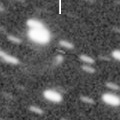
|
Now it is 17.6 mag (Apr. 26, Yasukazu Ikari). Fading slowly. It will be fainter than 18 mag soon. It stays observable in good condition.
Date(TT) R.A. (2000) Decl. Delta r Elong. m1 Best Time(A, h)
June 7 19 2.43 15 37.6 4.796 5.519 131 17.9 2:02 ( 0, 71)
June 14 18 54.85 15 17.6 4.778 5.555 136 17.9 1:27 ( 0, 70)
|

|
It brightened up to 13.1 mag in autumn (Nov. 1, Thomas Lehmann). Now it is 17.5 mag (June 4, Toshihiko Ikemura, Hirohisa Sato). Fading gradually. It stays observable in good condition.
Date(TT) R.A. (2000) Decl. Delta r Elong. m1 Best Time(A, h)
June 7 16 48.76 6 23.2 2.474 3.396 150 18.1 23:44 ( 0, 61)
June 14 16 39.60 4 56.3 2.550 3.463 149 18.2 23:07 ( 0, 60)
|
|
![]()
 C/2024 G3 ( ATLAS )
C/2024 G3 ( ATLAS ) 29P/Schwassmann-Wachmann 1
29P/Schwassmann-Wachmann 1 C/2021 G2 ( ATLAS )
C/2021 G2 ( ATLAS ) C/2022 N2 ( PanSTARRS )
C/2022 N2 ( PanSTARRS ) 48P/Johnson
48P/Johnson C/2025 F2 ( SWAN )
C/2025 F2 ( SWAN ) C/2022 E2 ( ATLAS )
C/2022 E2 ( ATLAS ) C/2022 QE78 ( ATLAS )
C/2022 QE78 ( ATLAS ) C/2024 E1 ( Wierzchos )
C/2024 E1 ( Wierzchos ) 65P/Gunn
65P/Gunn 49P/Arend-Rigaux
49P/Arend-Rigaux C/2014 UN271 ( Bernardinelli-Bernstein )
C/2014 UN271 ( Bernardinelli-Bernstein ) C/2023 R1 ( PanSTARRS )
C/2023 R1 ( PanSTARRS ) 43P/Wolf-Harrington
43P/Wolf-Harrington C/2024 J3 ( ATLAS )
C/2024 J3 ( ATLAS ) C/2023 C2 ( ATLAS )
C/2023 C2 ( ATLAS ) C/2024 J2 ( Wierzchos )
C/2024 J2 ( Wierzchos ) C/2024 L5 ( ATLAS )
C/2024 L5 ( ATLAS ) C/2023 T3 ( Fuls )
C/2023 T3 ( Fuls ) P/2023 S1 ( PanSTARRS )
P/2023 S1 ( PanSTARRS ) 47P/Ashbrook-Jackson
47P/Ashbrook-Jackson C/2023 H5 ( Lemmon )
C/2023 H5 ( Lemmon ) C/2023 F3 ( ATLAS )
C/2023 F3 ( ATLAS ) C/2022 R6 ( PanSTARRS )
C/2022 R6 ( PanSTARRS ) 496P/2024 S3 ( Hill )
496P/2024 S3 ( Hill ) 88P/Howell
88P/Howell C/2025 K1 ( ATLAS )
C/2025 K1 ( ATLAS ) C/2019 U5 ( PanSTARRS )
C/2019 U5 ( PanSTARRS ) C/2019 E3 ( ATLAS )
C/2019 E3 ( ATLAS ) C/2020 V2 ( ZTF )
C/2020 V2 ( ZTF ) C/2024 T5 ( ATLAS )
C/2024 T5 ( ATLAS ) 362P/(457175) 2008 GO98
362P/(457175) 2008 GO98 C/2021 S3 ( PanSTARRS )
C/2021 S3 ( PanSTARRS ) C/2019 L3 ( ATLAS )
C/2019 L3 ( ATLAS ) 302P/Lemmon-PanSTARRS
302P/Lemmon-PanSTARRS C/2024 G2 ( ATLAS )
C/2024 G2 ( ATLAS ) C/2023 Q1 ( PanSTARRS )
C/2023 Q1 ( PanSTARRS ) C/2024 G6 ( ATLAS )
C/2024 G6 ( ATLAS ) C/2024 X2 ( ATLAS )
C/2024 X2 ( ATLAS ) C/2024 G4 ( PanSTARRS )
C/2024 G4 ( PanSTARRS ) C/2023 V1 ( Lemmon )
C/2023 V1 ( Lemmon ) 12P/Pons-Brooks
12P/Pons-Brooks 13P/Olbers
13P/Olbers C/2023 U1 ( Fuls )
C/2023 U1 ( Fuls ) C/2023 H1 ( PanSTARRS )
C/2023 H1 ( PanSTARRS ) C/2022 U1 ( Leonard )
C/2022 U1 ( Leonard ) C/2024 B1 ( Lemmon )
C/2024 B1 ( Lemmon )![]()













































